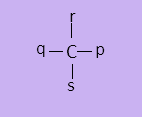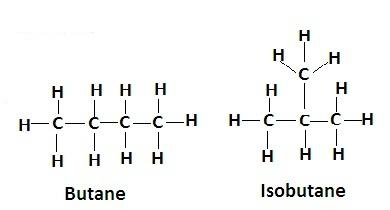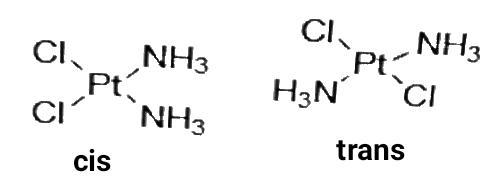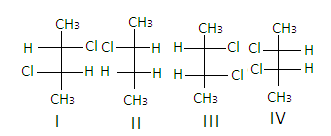
Which type of isomerism is shown in$2,3 - {\text{dichlorobutane}}$ ?
A) Structural B) Geometric C) Optical D) Diastereo
Answer
526.2k+ views
Hint :-In $2,3 - {\text{dichlorobutane}}$, the carbon on ${2^{{\text{nd}}}}$ and ${3^{{\text{rd}}}}$ position are chiral carbons(the carbon atom containing four different groups as its substituents).When we draw the structures of isomers, we also see that the images are mirror images of each other but they are not super imposable.
Complete Step By Step Answer:
$2,3 - {\text{dichlorobutane}}$ shows optical isomerism as it fulfills the following conditions-
1. The compound should have chiral carbons.
Ex-It should contain different atoms as its substituent like

2. The isomers must have non-super imposable mirror images.
It contains chiral carbons in ${2^{{\text{nd}}}}$ and${3^{{\text{rd}}}}$ positions as all the four groups attached to the carbons are different and it forms $4$ optical isomers which are non -super imposable mirror images of each other.

Hence, the correct answer is ‘C’.
Additional Information:
Let us also understand about other types of isomerism-
1. Structural isomerism is the isomerism in which the molecular formula is the same but the structure is different as the atoms have different arrangements. Ex- butane and isobutane have same molecular formula but their structures are different-

2. Geometrical isomerism is the isomerism in which spatial arrangement of ligands is changed. When the identical ligands occupy adjacent position it is called cis-isomer and when they are opposite to one other, it is called Trans isomer. It is also called cis-tans isomerism. Ex-

3. Diastereo isomerism is like optical isomerism but the isomers are not mirror images in this isomerism.
In the structure of$2,3 - {\text{dichlorobutane}}$, the structures I and III are diastereomers.

Note :
Optical isomers are the compounds having the same molecular formula but different spatial arrangement of atoms .The isomers form non-super imposable mirror images called enantiomers.
The mirror images when put upon each other are not superimposed because the arrangement of atoms differs.
Complete Step By Step Answer:
$2,3 - {\text{dichlorobutane}}$ shows optical isomerism as it fulfills the following conditions-
1. The compound should have chiral carbons.
Ex-It should contain different atoms as its substituent like

2. The isomers must have non-super imposable mirror images.
It contains chiral carbons in ${2^{{\text{nd}}}}$ and${3^{{\text{rd}}}}$ positions as all the four groups attached to the carbons are different and it forms $4$ optical isomers which are non -super imposable mirror images of each other.

Hence, the correct answer is ‘C’.
Additional Information:
Let us also understand about other types of isomerism-
1. Structural isomerism is the isomerism in which the molecular formula is the same but the structure is different as the atoms have different arrangements. Ex- butane and isobutane have same molecular formula but their structures are different-

2. Geometrical isomerism is the isomerism in which spatial arrangement of ligands is changed. When the identical ligands occupy adjacent position it is called cis-isomer and when they are opposite to one other, it is called Trans isomer. It is also called cis-tans isomerism. Ex-

3. Diastereo isomerism is like optical isomerism but the isomers are not mirror images in this isomerism.
In the structure of$2,3 - {\text{dichlorobutane}}$, the structures I and III are diastereomers.

Note :
Optical isomers are the compounds having the same molecular formula but different spatial arrangement of atoms .The isomers form non-super imposable mirror images called enantiomers.
The mirror images when put upon each other are not superimposed because the arrangement of atoms differs.
Recently Updated Pages
A man running at a speed 5 ms is viewed in the side class 12 physics CBSE

State and explain Hardy Weinbergs Principle class 12 biology CBSE

Which of the following statements is wrong a Amnion class 12 biology CBSE

Two Planoconcave lenses 1 and 2 of glass of refractive class 12 physics CBSE

The compound 2 methyl 2 butene on reaction with NaIO4 class 12 chemistry CBSE

Bacterial cell wall is made up of A Cellulose B Hemicellulose class 12 biology CBSE

Trending doubts
What are the major means of transport Explain each class 12 social science CBSE

Which are the Top 10 Largest Countries of the World?

Draw a labelled sketch of the human eye class 12 physics CBSE

Explain sex determination in humans with line diag class 12 biology CBSE

The pH of the pancreatic juice is A 64 B 86 C 120 D class 12 biology CBSE

Give 10 examples of unisexual and bisexual flowers




